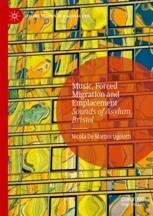References
-
Ahmed, S. (2004a). The cultural politics of emotion. Edinburgh University Press.
-
Anderson, B. (2016). Encountering affect: Capacities, apparatuses, conditions. Routledge.
-
Asquith, L., & Vellinga, M. (Eds.). (2005). Vernacular architecture in the twenty-first century: Theory, education and practice. Routledge.
-
Back, L. (2016). Moving sounds, controlled Borders: Asylum and the politics of culture. Young, 24(3), 185–203.
-
Beneduce, R. (2015). The moral economy of lying: Subject-craft, narrative capital, and uncertainty in the politics of asylum. Medical Anthropology, 34(6), 551–571.
-
Bhabha, H. K. (1996). Unsatisfied: Notes on vernacular cosmopolitanism. In L. Garcia Moreno & P. P. Pfeiffer (Eds.), Test and nation: Cross disciplinary essays on cultural and national identities (pp. 191–207). Columbia University Press.
-
Brah, A. (2005). Cartographies of diaspora: Contesting identities. Routledge.
-
Bristol City Council. (2017). Bristol: A City of Sanctuary Welcoming Asylum Seekers and Refugees Strategy. https://democracy.bristol.gov.uk/documents/s16871/01%20Welcoming%20Asylum%20Seekers%20and%20Refugees%20Strategy%20V5.pdf
-
Brković, C. (2023). Vernacular humanitarianism: An introduction. Social Anthropology/Anthropologie Sociale, 31, 1. https://doi.org/10.3167/saas.2023.310102
-
Darling, J. (2011). Giving space: Care, generosity and belonging in a UK Asylum Drop-in Centre. Geoforum, 42, 408–417.
-
Darling, J. (2014). Another letter from the Home Office: Reading the material politics of asylum. Environment and Planning D: Society and Space, 32, 484–500.
-
Darling, J. (2017). Forced migration and the City: Irregularity, informality, and the politics of presence. Progress in Human Geography, 41(2), 178–198.
-
Dawney, L. (2013). The interruption: Investigating subjectivation and affect. Environment and Planning D: Society and Space, 31, 628–644.
-
De Martini Ugolotti, N. (2022a). Music making and forced migrants’ affective practices of diasporic belonging. Journal of Ethnic and Migration Studies, 48(1), 92–109.
-
De Martini Ugolotti, N. (2022b). Contested bodies in a regenerating city: Post-migrant men’s contingent citizenship, parkour and diaspora spaces. Leisure Studies, 1. https://doi.org/10.1080/02614367.2022.2085775
-
De Martini Ugolotti, N., & Caudwell, J. (Eds.). (2022). Leisure and forced migration: Lives lived in asylum systems. Routledge.
-
De Martini Ugolotti, N., & Webster, C. (2023). Sites of intensity: Leisure and emotions amid the necropolitics of asylum. Leisure Studies, 43, 419. https://doi.org/10.1080/02614367.2023.2173798
-
Diouf, M. (2000). The Senegalese murid trade diaspora and the making of a vernacular cosmopolitanism. Public Culture, 12, 679–702.
-
Fassin, D., & D’Halluin, E. (2005). The truth from the body: Medical certificates as ultimate evidence for asylum seekers. American Anthropologist, 107(4), 597–608.
-
Fiddian-Qasmiyeh, E. (2016). Refugee-refugee relations in contexts of overlapping displacement. International Journal of Urban and Regional Research. http://www.ijurr.org/spotlight-on-overview/spotlight-urban-refugee-crisis/refugee-refugee-relations-contextsoverlapping-displacement/
-
Glick Schiller, N., Darieva, T., & Gruner-Domic, S. (2011). Defining cosmopolitan sociability in a transnational age. An introduction. Ethnic and Racial Studies, 34(3), 399–418.
-
Hughes, S. M., & Forman, P. (2017). A material politics of citizenship: The potential of circulating materials from UK immigration removal Centres. Citizenship Studies, 21(6), 675–692.
-
Hynes, P. (2011). The dispersal and social exclusion of asylum seekers: Between liminality and belonging. University of Bristol Policy Press.
-
Janeja, M. K., & Bandak, A. (2020). Ethnographies of waiting: Doubt, hope and uncertainty. Bloomsbury Academic.
-
Lewis, H. (2010). Community Moments: Integration and Transnationalism at ‘Refugee’ Parties and Events. Journal of Refugee Studies, 23(4), 571–588.
-
Lewis, H. (2015). Music, Dancing and Clothing as Belonging and Freedom among People Seeking Asylum in the UK. Leisure Studies, 34(1), 42–58.
-
Malkki, L. (1995). Refugees and exile: From ‘refugee studies’ to the National Order of Things. Annual Review of Anthropology, 24, 495–523.
-
Massey, D. (2005). For space. Sage.
-
Mayblin, L. (2017). Asylum after empire: Colonial legacies in the politics of asylum seeking. Rowman and Littleman.
-
Mayblin, L. (2020). Asylum and impoverishment: Social policy as slow-violence. Routledge.
-
Mayblin, L., Wake, M., & Kazemi, M. (2020). Necropolitics and the slow violence of the everyday: Asylum seeker welfare in the postcolonial present. Sociology, 54(1), 107–123.
-
Mbembe, A. (2003). Necropolitics. Public Culture, 15(1), 11–40.
-
Mbembe, A. (2020). The universal right to breathe. Critical Inquiry. Available at https://critinq.wordpress.com/
-
McGraw, A. (2020). Feeling the feels: Spinozist ethics and musical feeling in an American jail. Culture, Theory and Critique, 61(2–3), 267–282.
-
Mountz, A. (2011). Where asylum-seekers wait: Feminist counter-topographies of sites between states. Gender, Place & Culture, 18(3), 381–399.
-
Navaro, Y. (2012). The make-believe space: Affective geography in a postwar polity. Duke University Press.
-
Navaro-Yashin, Y. (2009). Affective spaces, melancholic objects: Ruination and the production of anthropological knowledge. Journal of the Royal Anthropological Institute, 15(1), 1–18.
-
Olszewska, S. (2015). The pearl of Dari poetry and personhood among young afghans in Iran. Indiana University Press.
-
Pollock, S. I. (2000). Cosmopolitan and vernacular in history. Public Culture, 12(3), 591–625.
-
Probyn, E. (2005). Blush: Faces of shame. University of Minnesota Press.
-
Rozakou, K. (2016). Socialities of solidarity: Revisiting the gift taboo in times of crisis. Social Anthropology, 24(2), 185–199.
-
Schmidt, D., & Palutan, G. (2022). Thick leisure: Waiting time in a migratory context. In N. De Martini Ugolotti & J. Caudwell (Eds.), Leisure and forced migration: Lives lived in asylum systems (pp. 52–66). Routledge.
-
Schmoll, C. (2014). Gendered spatialities of power in ‘borderland’ Europe: An approach through mobile and immobilised bodies. International Journal of Migration and Border Studies, 1(2), 173–189.
-
Van Aken, M. (2006). Dancing belonging: Contesting Dakbeh in the Jordan Valley, Jordan. Journal of Ethnic and Migration Studies, 32(2), 203–222.
-
Webster, C. (2022). The (in)significance of footballing pleasures in the lives of forced migrant men. Sport in Society, 25(3), 523–536.
-
Webster, C., & Abunaama, K. (2022). Informal football spaces and the negotiation of temporal politics in the lives of forced migrants. In N. De Martini Ugolotti & J. Caudwell (Eds.), Leisure and forced migration: Lives lived in asylum systems (pp. 21–34). Routledge.
-
Werbner, P. (2006). Vernacular Cosmopolitanism. Theory, Culture & Society, 23(2–3), 496–498.
-
Werbner, P. (2017). De-orientalising vernacular cosmopolitanism: Towards a local cosmopolitan ethics. In A. K. Giri (Ed.), Beyond cosmopolitanism towards planetary transformations (pp. 275–295). Palgrave Macmillan.
-
Zaman, T. (2020). Neighbourliness, conviviality, and the sacred in Athens’ refugee squats. Transactions of the Institute of British Geographers, 45(3), 529–541.
